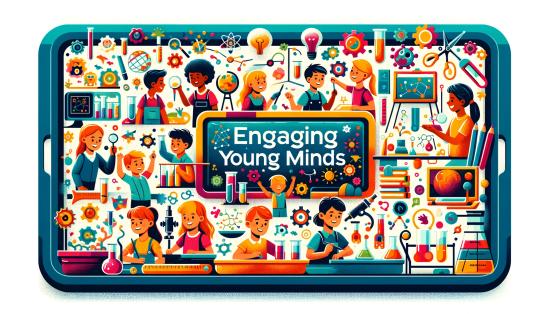
Engaging Young Minds: Effective Strategies for Science Education and Outreach
Exploring effective strategies for science education and outreach to engage young minds and inspire a lifelong passion for discovery.
Introduction to the importance of science education and outreach for shaping future generations. Science education and outreach are essential for shaping the next generation of thinkers, innovators, and problem solvers. By engaging young minds in the wonders of the scientific world, we can instill a lifelong curiosity and passion for discovery. Through education and outreach, we have the opportunity to inspire the scientists, engineers, and leaders of tomorrow. It is crucial to provide accessible, engaging, and relevant science experiences to all students, regardless of their background or abilities. Effective science education and outreach can also help to bridge the gap between the scientific community and the general public, fostering a greater understanding and appreciation for the importance of science in our daily lives.
Examining the current challenges in science education reveals several factors that affect student engagement. One of the major hurdles is the lack of resources and funding for hands-on experiments and interactive learning activities. Without access to proper laboratory equipment and materials, students may struggle to grasp scientific concepts and become disengaged from the subject. Additionally, the traditional one-size-fits-all approach to teaching science fails to cater to the diverse learning styles and interests of students, leading to reduced motivation and participation in class. Furthermore, the shortage of qualified science instructors and limited professional development opportunities can hinder the delivery of engaging and effective science education. These challenges collectively contribute to a decline in student engagement and interest in science, highlighting the need for innovative approaches and support in science education.
Experiencing science through hands-on activities is a crucial element in science education, as it can significantly improve students' understanding and retention of scientific concepts. By engaging in experiments, explorations, and interactive projects, students are able to apply theoretical knowledge in practical settings, allowing them to experience firsthand the principles and laws of science. This hands-on approach not only stimulates curiosity and creativity but also promotes a deeper comprehension of complex scientific ideas. Furthermore, active participation in scientific activities has been shown to enhance student motivation and confidence, leading to better academic performance and a long-term interest in science. As educators and mentors, providing opportunities for students to actively engage with science through hands-on activities is essential for fostering a lifelong passion for learning and discovery.
The role of technology in modern science education is of utmost importance, especially when it comes to interactive learning tools and resources. With the advancement of technology, educators have a wide array of tools at their disposal to make science education more engaging and effective. Interactive simulations and virtual laboratories allow students to conduct experiments and explore scientific concepts in a virtual environment, fostering a deeper understanding of complex scientific ideas. Additionally, digital platforms and apps provide access to a wealth of scientific resources, such as eBooks, videos, and interactive quizzes, that cater to different learning styles and abilities. These tools not only make learning more interactive and fun but also help students develop important digital literacy skills that are crucial in today's world. By leveraging technology in science education, educators can create a more dynamic and immersive learning experience that prepares students for the demands of the modern world.
Effective communication in science outreach is essential for bridging the gap between complex scientific concepts and the broader public audience. In order to engage and educate a diverse audience, scientists and science communicators must be able to explain complex ideas in a clear and accessible manner. This requires the ability to distill intricate theories and principles into digestible information that resonates with people from different backgrounds and levels of scientific literacy. By using relatable examples, analogies, and storytelling techniques, scientific communicators can make complex concepts more approachable and easier to understand for a broader audience. Furthermore, employing visual aids, such as infographics, diagrams, and videos, can enhance the communication of scientific ideas by providing visual representations that complement verbal explanations. By simplifying complex concepts through effective communication, science outreach efforts can broaden their impact and inspire curiosity and interest in science among the general public.
Collaboration between schools and scientific communities is essential for enhancing learning opportunities for students. By working together, educators and researchers can create enriching experiences that bring real-world scientific exploration into the classroom. This partnership can involve organizing field trips to research labs, inviting scientists to give special lectures, or even participating in joint research projects. Such collaborations not only expose students to the latest scientific developments but also provide them with mentorship and guidance, sparking their interest and passion for science. By bridging the gap between academic institutions and the scientific community, students can gain a deeper understanding of scientific concepts and develop critical thinking and problem-solving skills that will serve them well in their future careers.
Integrating storytelling in science teaching can revolutionize the way students engage with and understand scientific concepts. By weaving narratives into lessons, educators can make learning more relatable and inspiring, sparking curiosity and passion for the subject. Stories have the power to humanize scientific discoveries, making them more accessible to students and igniting their imagination. Through storytelling, educators can contextualize complex theories and principles, connecting them to real-world applications and historical contexts. This approach not only enhances students' understanding but also cultivates empathy and emotional engagement, leading to a deeper appreciation for the wonders of science.
Assessing the impact of science fairs and competitions on student motivation and interest is crucial for understanding the effectiveness of these extracurricular activities in promoting a lasting passion for science. Science fairs and competitions provide students with a platform to showcase their innovative projects and scientific discoveries, fostering a sense of accomplishment and recognition for their hard work. These events not only encourage students to delve deeper into their scientific inquiries but also nurture their competitive spirit while fostering collaboration and creativity. Moreover, participation in science fairs and competitions exposes students to a diverse range of scientific fields, sparking curiosity and interest in various branches of science. By assessing the impact of science fairs and competitions on student motivation and interest, educators and policymakers can gain valuable insights into the factors that drive and sustain students' enthusiasm for science, ultimately shaping effective strategies for science education and outreach.
Role models and mentorship play a significant role in driving interest in STEM fields among young students. When students have access to role models who are successful in science, technology, engineering, and mathematics, it can inspire them to pursue similar paths. Mentorship programs provide students with guidance, support, and real-world insights into STEM careers, which can be crucial for shaping their educational and professional aspirations. By interacting with successful professionals in STEM fields, students can gain valuable advice, encouragement, and practical knowledge, which can fuel their passion for science and technology. Additionally, seeing individuals who look like them and come from similar backgrounds succeeding in STEM can help students envision themselves in similar roles, breaking down barriers and stereotypes that may have previously discouraged them from pursuing these fields.
In conclusion, fostering a lifelong interest in science requires a multi-faceted approach that incorporates various strategies. Encouraging students to engage in hands-on activities can greatly enhance their understanding and retention of scientific concepts, as well as stimulate curiosity and promote long-term interest in science. The role of technology in modern science education is crucial, particularly in the realm of interactive learning tools and resources. Effective communication in science outreach is vital for simplifying complex concepts and making them relatable to a broader audience. Collaboration between schools and scientific communities enhances learning opportunities by bringing real-world scientific exploration into the classroom. Integrating storytelling in science teaching makes learning more relatable and inspiring, while science fairs and competitions provide students with recognition for their hard work and expose them to diverse fields of science. Finally, the contribution of role models and mentorship is essential in driving interest in STEM fields.
Related posts






